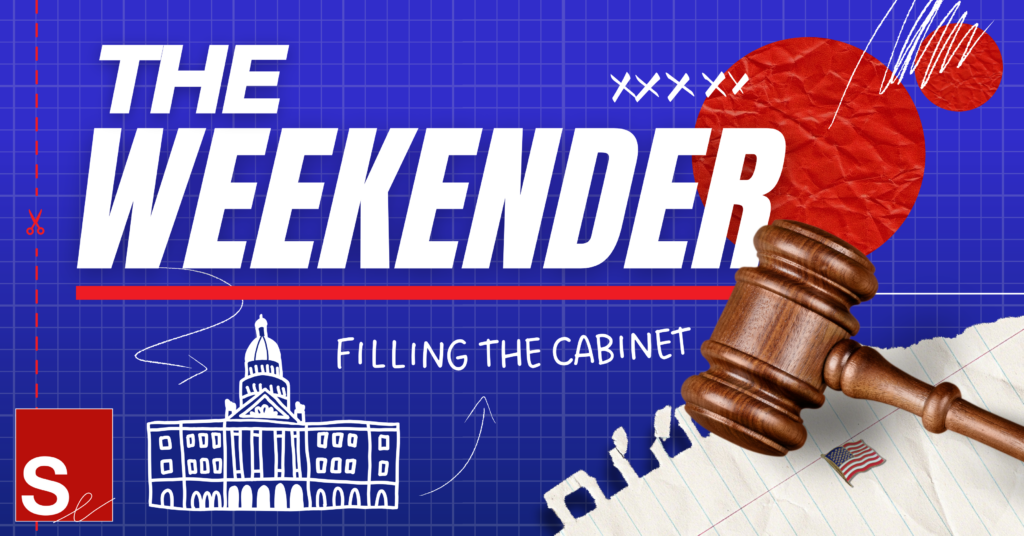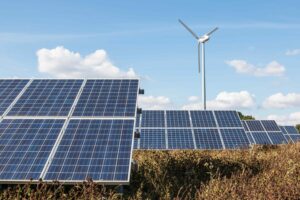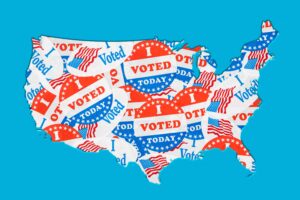DATA POINTS
- 3: The number of seats currently flipped by Republicans in the U.S. Senate
- 7: The number of seats currently flipped by Republicans in the U.S. House of Representatives
- 19: The number of podcasts Trump and Harris spoke on before Election Day
- 33%: The percentage bitcoin has gone up in value since Election Day
- 43: The number of monkeys that escaped a research lab in South Carolina
- 312: The final electoral vote count for President-elect Donald Trump
Getting the Team Back Together
President-Elect Donald Trump is wasting no time filling critical positions in his second-term Cabinet. Although it’s only been ten days since he won the election, his leadership team picks will give a glimpse into how the Trump Administration will handle the next four years.
Stephen Miller was selected as his deputy chief of staff for policy, former NY Congressman Lee Zeldin will serve as the head of the EPA, and FL Congressman Mike Waltz will take the reins as national security advisor. NY Representative Elise Stefanik will serve as Trump’s Ambassador to the U.N., following in Nikki Haley’s footsteps. 34-year Border Patrol veteran Tom Homan will serve as his “Border Czar,” former AR Governor Mike Huckabee will handle critical international affairs as the U.S. Ambassador to Israel, and former Director of National Intelligence John Ratcliffe will move in as the new CIA Director. Marco Rubio has been tapped to be Secretary of State, SD Governor Kristi Noem will step in as Secretary of Homeland Security, and yes – RFK Jr. will lead the Department of Health.
For MAGA Republican politicos and diehard Fox News viewers, this list is a wild mosaic of who’s-who. Their appointments will have significant impacts on the future of government programs and nationwide funding priorities. They’re also likely to be the faces you’ll see more often on the talk show lineups. The story is only beginning.
 TrumpTok
TrumpTok
Donald Trump promised to throw a bone to Gen Z on the campaign trail by “saving TikTok” – and he is expected to follow through.
How did we get here? A bipartisan U.S. law passed during the Biden Administration would have forced ByteDance, TikTok’s Chinese-owned company, to divest from TikTok or be banned in the U.S. The deadline was set for Jan. 19 – one day before the 2025 inauguration. For way-too-fun-to-miss coverage on this law, check out story #2 in this edition of The Weekender (we promise you won’t regret it).
Trump has been vocal about his dislike for outright bans on pretty much everything and instead hopes individual choice and the free market can determine direction on issues. Still, if Trump directs Congress to halt the ban, it would be a stark contrast to his regular tone of attacking China at every opportunity. After all, it was national security concerns from both top Republicans and Democrats that led to the divest-or-ban plan in the first place.
In 2022, ByteDance offered the Biden Administration a compromise dubbed “Project Texas,” which would have given the Oval Office tremendous decision-making in the company’s workforce and technical underpinnings in exchange for the U.S. consumer base. Biden declined. Will self-proclaimed “Master of the Deal” Trump bring them back to the table for the compromise?
Read More at The Washington Post
The Global Emission Condition 
Look at these photos of Venus’ surface and you’ll notice one thing almost immediately: runaway greenhouse gases don’t paint a pretty picture. While the Earth is not anywhere near Venus’ CO2 levels, our greenhouse gas (GHG) levels from burning traditional fuels are hitting a new peak. Worldwide emissions are expected to increase by 0.8% to 37.4 billion metric tons – the highest annual growth rate over the past decade. CO2 emissions are 8% higher now than they were when the 2015 Paris Agreement was signed.
India and China’s increased use of coal, international aviation, and natural gas burning are major factors causing the numbers to rise. China, despite a record growth in its renewable energy sector, is also expanding its traditional fuel sector to meet its economic needs. As the demand for renewable energy from the largest corporations in the world grows, nations are installing more wind, solar, hydroelectric, geothermal, and battery storage when and where they can. If countries are serious about mitigating climate change, they will need to quickly and aggressively roll out more clean energy projects.
And Then There Were Two…
Bush, Bush, Obama, Obama, Trump, Biden, Trump; these were the winners of every Presidential election this century (technically, the century began in 2001, but we don’t care). Although successfully voting for every to-be president won’t net you as much money as putting together a 100% correct March Madness bracket, it will put your county on the map every election cycle from here on out.
In 2008, 278 counties had voted for the winning president in every 21st century election. In 2012, 129 counties were batting 1,000. In 2016, the number halved to 58. In 2020, only nine counties remained undefeated. After the 2024 election, just two counties held their perfect record: Blaine County, Montana and Essex County, New York.
Essex County went 50.2% Trump and 49.8% Harris, keeping their flawless tag by a mere 72 votes. 174 voters wrote in someone else, being unhelpful for candidates but saviors to Essex County’s record. Like a speedboat dumping its own fuel to reduce weight and cross the finish line first, tossing the votes clutched the win. Blaine, Montana was decided by a 200-vote margin in favor of Trump, 51% to 44.2%.
Read More at The Washington Post
“Siri: Remind me to read The Weekender after work.”
What do shopping lists, jokes, best man speeches, poetry, first date questions, baby names, half-baked business ideas, and random shower thoughts all have in common? They are all found in Apple Notes. Notes has become a direct extension of our brains, allowing us to remember anything and everything, so long as we don’t forget to check the app. Siri reminders are just as ubiquitous, enabling us to have our smart phone remind us to change our laundry, call our loved ones, and finish that work project we’ve been procrastinating. GPS screens in our cars prove that we don’t need to learn local routes to get to where we need to go. Memory and recall are one of, if not the most, critical parts of human intelligence, so it begs the question: what is the impact of technological convenience doing our remembering for us?
Studies have found that if users over-rely on technology to act as an external memory hard drive, they will lose old memories’ synapses because of disuse in the same way any other muscle will shrink if not used for long enough. Therefore, training is the key. For example, if you decide to learn a new language, you will need to continually practice for years before it transfers from short-term to long-term memory. If you use Google Translate, you may recognize the words, but you’ll be less likely to recall them without tech by your side.
It’s not all bad, however, since neuroimaging shines a light on what happens in our brains when we recall information. As it turns out, the same part of the brain that remembers past events is the same mechanism that imagines future events.
So, maybe having some tech-fueled recall built into our daily lives isn’t a bad thing, so long as we aren’t over-dependent on it and still flex our memory muscles every so often.
Read More at The Wall Street Journal
See you next week!
Be sure to follow us on Facebook, Twitter, and LinkedIn for more news and industry updates. To receive a copy of The Weekender in your inbox, sign up here.










